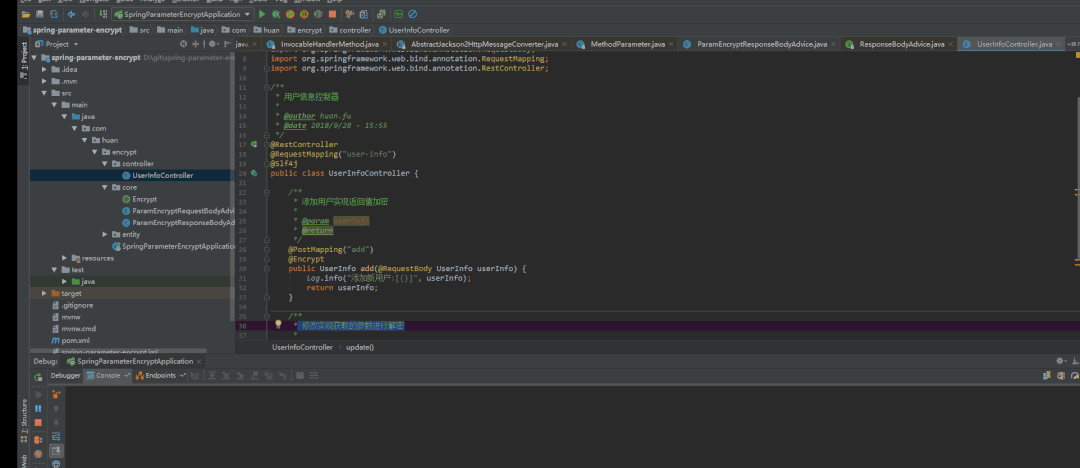基于 RequestBodyAdvice 与 ResponseBodyAdvice 实现统一加密和解密
共 8652字,需浏览 18分钟
·
2021-05-24 21:48
在日常开发中,有时候经常需要和第三方接口打交道,有时候是我方调用别人的第三方接口,有时候是别人在调用我方的第三方接口,那么为了调用接口的安全性,一般都会对传输的数据进行加密操作,如果每个接口都由我们自己去手动加密和解密,那么工作量太大而且代码冗余。那么有没有简单的方法,借助 spring 提供的 RequestBodyAdvice 和 ResponseBodyAdvice 可以实现解密和加密操作。
需求:
后台方法上如果有 @Encrypt 注解和 @RequestBody 修饰的方法,需要进行参数的解密
后台方法上如果有 @Encrypt 注解和 @ResponseBody 修饰的方法,需要进行参数的加密
加密和解密规则
加密:对返回的值中增加 -encrypt 值
解密:对传入的值中删除 -encrypt 值
注:
@Encrypt 为自定义的一个注解。
此处为了简单,就使用删除或增加 -encrypt 这个,实际情况下可以使用复杂的加解密规则
0x01: 基本思路介绍
RequestBodyAdvice:在 sping 4.2 新加入的一个接口,它可以使用在 @RequestBody 或 HttpEntity 修改的参数之前进行参数的处理,比如进行参数的解密。
ResponseBodyAdvice:在 spring 4.1 新加入的一个接口,在消息体被 HttpMessageConverter 写入之前允许 Controller 中 @ResponseBody 修饰的方法或 ResponseEntity 调整响应中的内容,比如进行相应的加密。
0x02: 功能实现步骤
1. 编写加密注解类(Encrypt)
@Target({ElementType.PARAMETER, ElementType.METHOD})
@Retention(RetentionPolicy.RUNTIME)
@Documented
public @interface Encrypt {
} 2. 编写RequestBodyAdvice接口实现类,实现数据的解密操作
@Slf4j
@RestControllerAdvice
public class ParamEncryptRequestBodyAdvice implements RequestBodyAdvice {
@Override
public boolean supports(MethodParameter methodParameter, Type type, Class<? extends HttpMessageConverter<?>> aClass) {
return methodParameter.hasParameterAnnotation(RequestBody.class);
}
@Override
public Object handleEmptyBody(Object o, HttpInputMessage httpInputMessage, MethodParameter methodParameter, Type type, Class<? extends HttpMessageConverter<?>> aClass) {
return o;
}
@Override
public HttpInputMessage beforeBodyRead(HttpInputMessage httpInputMessage, MethodParameter methodParameter, Type type, Class<? extends HttpMessageConverter<?>> aClass) throws IOException {
return new HttpInputMessage() {
@Override
public InputStream getBody() throws IOException {
log.info("此处进行解密数据");
return new ByteArrayInputStream(IOUtils.toString(httpInputMessage.getBody()).replace("-encrypt", "").getBytes(StandardCharsets.UTF_8));
}
@Override
public HttpHeaders getHeaders() {
return httpInputMessage.getHeaders();
}
};
}
@Override
public Object afterBodyRead(Object o, HttpInputMessage httpInputMessage, MethodParameter methodParameter, Type type, Class<? extends HttpMessageConverter<?>> aClass) {
return o;
}
} 3. 编写ResponseBodyAdvice接口实现类,实现数据的加密操作
@Slf4j
@RestControllerAdvice
public class ParamEncryptResponseBodyAdvice implements ResponseBodyAdvice {
private final ObjectMapper objectMapper = new ObjectMapper();
@Override
public boolean supports(MethodParameter returnType, Class converterType) {
return returnType.hasMethodAnnotation(ResponseBody.class);
}
@Override
public Object beforeBodyWrite(Object body, MethodParameter returnType, MediaType selectedContentType, Class selectedConverterType, ServerHttpRequest request, ServerHttpResponse response) {
log.info("此处进行加密数据");
if (null != body) {
try {
Map map = objectMapper.readValue(objectMapper.writeValueAsString(body), Map.class);
map.forEach((key, value) -> map.put(key, value + "-encrypt"));
return map;
} catch (IOException e) {
log.error("加密数据失败.", e);
}
}
return body;
}
} 4. 编写控制层进行测试
@RestController
@RequestMapping("user-info")
@Slf4j
public class UserInfoController {
/**
* 添加用户实现返回值加密
*
* @param userInfo
* @return
*/
@PostMapping("add")
@Encrypt
public UserInfo add(@RequestBody UserInfo userInfo) {
log.info("添加新用户:[{}]", userInfo);
return userInfo;
}
/**
* 修改实现获取的参数进行解密
*
* @param userInfo
* @return
*/
@PostMapping("update")
public UserInfo update(@Encrypt @RequestBody UserInfo userInfo) {
log.info("修改用户信息:[{}]", userInfo);
return userInfo;
}
} 5. 测试参数的解密操作

可以看到:参数中的 -encrypt 传递后后台被后台自动截取了,这样就类似于解密操作。
6. 测试返回值的加密操作
可以看到:返回的值后面都有一个 -encrypt, 这样就实现了类似于加密操作。

喜欢,在看
